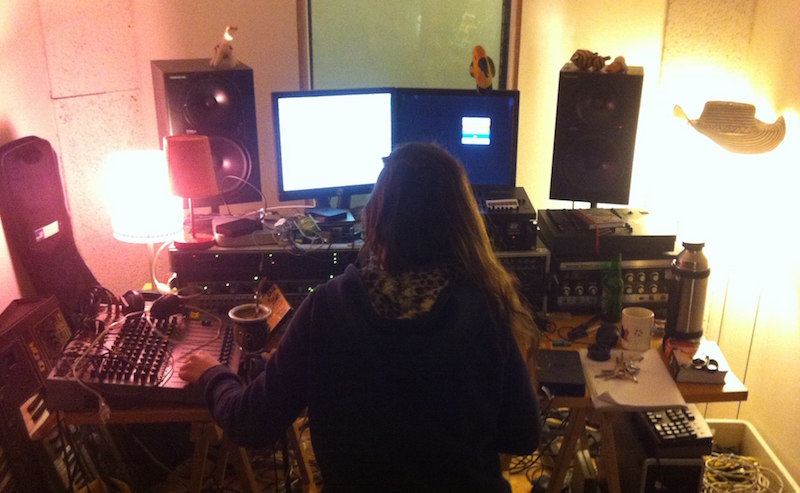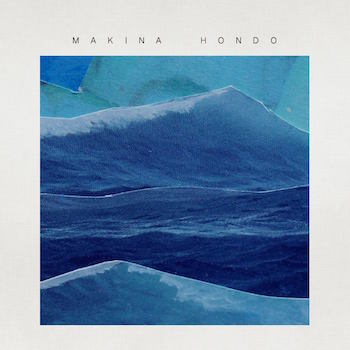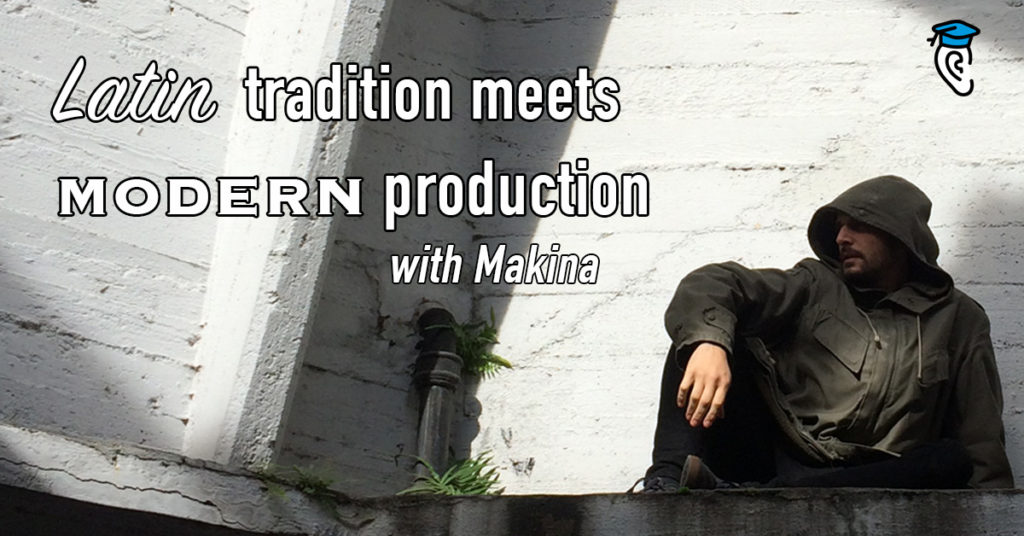Hernan Ambrogi is an Argentinian musician who produces electronic music with a Latin folkloric flair under the name Makina. In our recent tutorial on cumbia music we featured a track from his “Gringas” EP in which he blended pop and indie hits with classic latin beats.
He’s now working on a new album, hondo, to be released on the Dutch label Ini Movement, exploring the combination of electronic music production with traditional tango instruments.
We invited Hernan to share more about his creative process, how he merges genres, and the advice he has for pushing your creativity to its full potential.
Q: So to begin could you tell us a bit more about yourself and your musical background?
Well, I started making music when I was 12. I started playing guitar and I’m still playing guitar today at 34. And by the time I was 17 or 18, I started listening to electronic music—Daft Punk and the French electro stuff—and I was blown away.
So, I decided to start getting into production and electronic music. So when I was 19, I went on a trip which took me to Amsterdam and I just stayed. I lived there for 13 years and I studied production there and started making French electro mainly. And then into yeah house, techno, and hip-hop and different kinds of production methods. And I had different projects like Ricky y Rulo, Crunkd, Denver and others.
I started making music as Makina. The trigger was that at some point I re-discovered cumbia. There was an album called Psychedelic Cumbias from Peru. Everybody knows it. When I was teenager I was into heavy metal but here in Argentina, Cumbia—I mean you hear it all the time. So when we were going out with my friends, we danced Cumbia. So it’s something that I have inside.
So I thought it was interesting to combine Cumbia with electronic music. So I started experimenting with samples and combining them with all these different techniques I learned through the years of electronic music production.
Yeah, that’s how the first EP was born, Potro, and then I released another EP which is called Gringas. That one has the song you included in your article. I did 4 remixes/edits.
I thought it would be funny to take English-speaking singers and put them in the context of Cumbia and electronic music. So that’s what I did. And so I did that for a few years and now Makina has evolved into combining more. I’m about to release an album now with Ini Movement, that’s a label in Holland. And now I combine different kinds of folkloric music, not only Cumbia. Actually this album is sort of a conceptual album for electronics, and bandoneon and guitarra criolla which are usually two typical instruments from tango. So now I have tried to create a new aesthetics for these instruments in this new context.
Listen to De Nuevo from the new album “hondo”
Well I did study at the University there. It’s called the Hogeschool voor de Kunsten, Utrecht. So it’s not exactly in Amsterdam but in another city. I studied for 6 years, bachelors and 2 masters in music production. I learned a lot—but actually I learned the most by doing.
So when I finished the studies I was working as a producer for an artist, and I’m also a DJ. When I finished the studies was when I think I learned the most actually, just by doing and analyzing and always trying to learn new stuff.
I did study a lot of music theory. Like harmony and stuff like that ever since I started playing guitar, because I really like music and I want to know everything I can.
You have to study a lot – and then you have to forget everything and make music.
There is this saying that goes “you have to study a lot – and then you have to forget everything and make music”. I think that’s what I did and what I do regularly. So, you have to study so that it’s inside of you, and then you have to forget it somehow, like not being conscious of that. I think that’s the way I learned.
Yes. But that was not a conscious decision. I was always making my own songs. That just came naturally to me.
I started learning where you learn songs from other artists. You learn about structure, about harmony. That’s something that later you’re playing with on your own music I guess.
It is different with every song actually. I am not somebody who repeats the same structure or the same method every time. Not because I want to break the rules, it’s just that I don’t do it the same way every time.
Lately I’m really into samples. I like working with samples because like when I compose with the guitar, it has certain… rules I cannot break. But when I’m working with samples I don’t think about tonality or function of the chords. I just like what I hear. Later on I can analyze what’s going on—but I want to feel it and not think about it.
I love working with samples. And it’s not because I don’t play an instrument, I do play an instrument. But I like this process better, I think.

In a way yes. I mean when it comes to electronic music, yes.
I also really enjoy having my computer turned off and just playing guitar. To have a cumbia band in Amsterdam was interesting because during the day I would do studio work and I had to be very sharp in the studio and do all this work. And in the evenings I would play guitar which was completely the opposite! Like not thinking, no computers, and just feel the music from another side, you know.
What’s your perspective on that—like what kinds of things do you listen for in a music and have you done any particular practice to get your ear really get tuned into what you need to, for your own music creation?
That’s an interesting question. I still train my ear every day when I listen to music. There are very different ways of listening to music. It’s one thing to listen to music without thinking about it and another to consciously analyze the music. And I think that’s a very interesting process.
 Like you can listen to a track on your iPod then you play it in your studio. And sometimes what I even do is just put it in a track I like in Ableton Live and I kind of dissect it into all the different parts and see “okay, you have the chorus… and what are the instruments that are playing there—what is the difference with the verse.” But also listen to headroom and impact from the drums, or how the kick and the bass interact. I mean there are a lot of different points of view you can use to analyze a track. I try to use them all.
Like you can listen to a track on your iPod then you play it in your studio. And sometimes what I even do is just put it in a track I like in Ableton Live and I kind of dissect it into all the different parts and see “okay, you have the chorus… and what are the instruments that are playing there—what is the difference with the verse.” But also listen to headroom and impact from the drums, or how the kick and the bass interact. I mean there are a lot of different points of view you can use to analyze a track. I try to use them all.
I’m also a teacher of electronic music here in Argentina, in a school that is part of the Berklee International Network, and in this courses, I teach the students also about how to listen and how to analyze.
Yeah, most definitely. I think that’s something every musician or composer or producer does to learn about music. I think you need to learn what to look for in what you’re listening to. Like to learn what you’re searching for.
For your composing, is that how you approach it? Would you imagine the track in your head before you sat down with Ableton or with your guitar, or do you sit down and experiment and see what emerges?
Yeah well, what I really like about Ableton Live is the second option you mentioned. Like I never know beforehand what I’m going to end up with. So I really love that journey.
So what I do is try to—because the process on the computer of electronic music-making with all the countless options you have can be a bit much, you can get lost in that—so in the last few years, I developed a way of doing more of the old way of doing things: pre-production, production and post-production.
And that would involve like in the pre-production, working on my samples, working on the influences and having everything ready, so that when I’m going to compose or produce, nothing interferes with the process of creation. So I don’t have to be looking for this specific shaker sound or that hi-hat sound. Everything is already there and well-organized. So when I’m creating, that process isn’t stopped.
The old way of making music, it’s more linear. You make a track on the guitar, then you go to your band, you show it to the guys, then you arrange it, then you record it, then you mix it. But in electronic music, everything is more circular. You’re doing everything at the same time. And that sometimes can be a bit confusing that’s why I like to divide it into the different parts.
Yeah, mainly the pre-production and production. When you’re producing, you are already making a mix and sort of mastering.
What inspired that EP was kind of a joke. Like trying to take something really pop and hipster and put it into the cumbia context which can be considered more Latin or whatever… yeah, I don’t agree with that. So it’s maybe trying to show… I mean i never have an idea like “yeah, I’m going to break the rules now”, I’m just having fun, you know.
Yeah, you got it, right. I think that’s the idea behind Gringas. Because in the end, everything follows the same structure and the same musical rules. You know, the track is in four/four, you have the vocal there, you have the tonality or you put in the tonality that you want, and then it’s the same. So it was very easy, actually!
It depends on which track… Like the first track from Lana del Rey, it’s more of an edit. I made a cumbia beat and I added the whole track, let’s say I chopped it a bit. On the one that you chose for your website, the Jenny Willson one, I only took the vocals. So I did all the music and everything. So on these four tracks, the process was different.
 That idea came from just a jam session. I was with two friends of mine who are amazing instrumentalists. The bandoneon player is amazing and the guitar player is as well. So I was playing some loops and beats I had made, and they improvised on top of it.
That idea came from just a jam session. I was with two friends of mine who are amazing instrumentalists. The bandoneon player is amazing and the guitar player is as well. So I was playing some loops and beats I had made, and they improvised on top of it.
And then I took those recordings and I worked on them for a long time, and I changed the context—like if they had played on one track then I would use it for another track and so on. I discovered that the bandoneon, man it’s such an amazing instrument! I was blown away by it, and all the harmonics it has.
At the moment I was making this album, I also—I don’t know—grew older, I guess! But I had the idea of making something not only for the dance floor, but something you could also listen to. So it’s more relaxed than my previous EPs.
Listen to ay vidita from the new album “hondo”
Yes. Like learning and trying to reproduce other artists’ tracks. I think that’s a very helpful process.
Like when you learn a track on a guitar from somebody else, you learn so much about structure or melody. And you’re learning in a conscious and also in an unconscious way. And when you try to get a sound for a house track, it’s the same.
Like you make something and I always tell the students to try to have a few tracks on their sequencer and try to compare from time to time, the sound they have and the sound the professional track has. And try to see what is the difference, and where is the problem, and how to achieve the other sound.
Make.
Finish.
Analyze.
I think what I can suggest to people is to make a lot, and to finish the tracks. That’s something we all struggle with of course! I have thousands of projects I never finish.
When you finish something, you can reflect on it. When you leave all the options open, you don’t move forward, you know. You’re stuck at one point.
So when you finish something then you can listen to it and say “Okay, this lacked this”. Or sometimes what happens is that I listen to old tracks I didn’t think were good at that time, and then I listen to them half a year later and think “Well man, this was finished. It was good”.
So yeah. Make. Finish. And analyze.
One more thing: Take every project like it is the final exam. Try to do it always the best you can.
Don’t think “Uhhh okay, I’ll do this later” or “Well it doesn’t matter”.
If you know it can be better, do it. Don’t be lame with yourself.
I think so too, man.
The new Makina record will be released by Ini Movement later this year. You can hear a pre-release track from the record below. Follow Makina on SoundCloud and Facebook for more!







